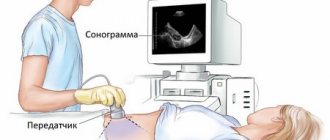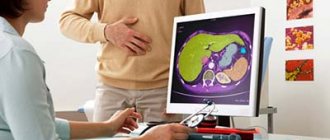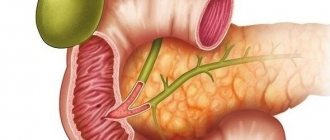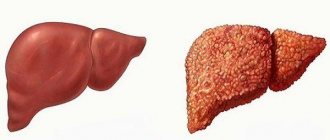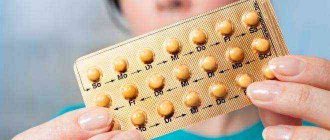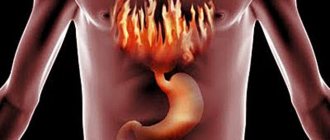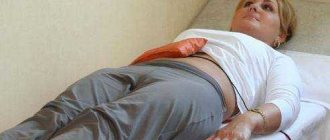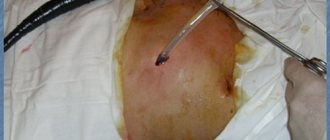Causes of liver inflammation
Inflammatory liver diseases have different causes. The best known are viral hepatitis caused by viruses of the same name (hepatitis A virus, hepatitis B virus, etc.). Other viral diseases can also lead to liver inflammation: rubella, herpes, cytomegalovirus, etc. The cause can also be bacteria or helminthic infestations.
Since the liver takes the hit of toxins, alcoholic hepatitis, drug-induced hepatitis, and toxic hepatitis occur when certain substances are abused or poisoned.
Causes of gallbladder inflammation
The gallbladder becomes inflamed due to the ingress of infectious agents, parasites and protozoa. Most often, the cause of cholecystitis is opportunistic flora, which is activated when immunity decreases. Staphylococci, streptococci, Giardia, Proteus, opisthorchis and other pathogens enter the gallbladder from the intestines, bloodstream or lymph flow.
Provoking factors for cholecystitis:
- biliary dyskinesia;
- chronic infections in any organ, including teeth;
- physical inactivity;
- nutritional disorders - excessive or insufficient diet, heavy dinners, an abundance of fatty foods;
- hormonal imbalances;
- elderly age;
- immunodeficiency.
If the disease is cured in less than 3 months, they speak of acute inflammation. Chronic cholecystitis sometimes drags on for years, progresses with exacerbations and subsidence.
General symptoms
Diseases of both the liver and gallbladder can be asymptomatic. Sometimes only one symptom appears over a long period of time, for example, bitterness in the mouth.
Inflammation of both organs is characterized by pain in the right hypochondrium, in rare cases - on the left or closer to the back, more often appearing after eating fatty foods or heavy exertion. The pain can be sharp, dull, aching, sharp, etc., attacks last from several minutes to a day. Periodically occurring nausea and fever occur in many diseases.
Basic functions of the liver and gallbladder
The work of the liver and gallbladder is interconnected. Both of these organs take part in digestion. Liver cells secrete bile. This secretion enters the small intestine and enhances its motility, participates in the breakdown of fats, activates enzymes, and neutralizes the acids of the stomach contents. Under the influence of bile, amino acids, calcium salts, cholesterol, vitamins A, D, E and K are more completely absorbed, and the spread of bacteria is suppressed.
The liver is involved in all types of metabolism:
- in protein metabolism, it breaks down and converts proteins, transforms amino acids into a reserve energy source and raw materials for the body to build its own cells and tissues;
- in the process of carbohydrate metabolism, the liver forms and accumulates glycogen - a reserve energy substrate;
- During fat metabolism, the liver and gall bladder break down lipids into fatty acids and ketone bodies and produce cholesterol.
The liver maintains the balance of nutrients in the body. If there are not enough carbohydrates in food, they will be synthesized from proteins. And when a person eats a lot of sweets, the excess sugar turns into fats.
In addition to these functions, the liver takes part in the synthesis of hormones, anticoagulants, regulates the exchange of microelements, protects the body from toxins, and maintains homeostasis. Bile is produced in the liver and stored in the gallbladder. The treatment of these organs is always interconnected.
Specific symptoms
The diagnosis of hepatitis and cholecystitis is not made based on 2-3 symptoms. The presence of signs from the list allows you to suspect the disease and consult a doctor. The doctor will palpate the liver and prescribe examinations, based on the results of which he will make a final diagnosis and prescribe treatment.
Liver
Symptoms of liver inflammation:
- weakness for no apparent reason;
- severe loss of appetite;
- yellowish tint to the skin and sclera;
- itching all over the body or in the abdominal area;
- darkening of urine, light or yellowish color of stool.
Gallbladder
The following symptoms indicate the presence of cholecystitis:
- bitter taste in the mouth;
- flatulence, nausea, stool disorders;
- An increase in body temperature usually occurs in the evenings.
Nonspecific symptoms of the disease
As mentioned above, specific symptoms of liver disease may be absent for a long time. But there are also more general, but no less unpleasant, symptoms that indirectly indicate liver pathology. The main ones are:
- Weakness, high fatigue, malaise and other manifestations of nervous and mental pathology;
- Aches in joints, muscles;
- Skin rashes and subcutaneous hemorrhages;
- Temperature increase;
- Anemia.
Treatment
If the cause of inflammation is known, first of all you need to work on eliminating it. Treat concomitant diseases, adjust your diet. If hepatitis occurs as a result of excessive intake of various medications or alcoholic beverages, reduce medication intake and give up alcohol.
If cholecystitis is accompanied by the presence of large stones, a decision may be made to crush the stones with ultrasound or to remove the gallbladder surgically.
This is interesting: The first signs and symptoms of liver inflammation in women
Medication
For viral inflammation of the liver, drugs are prescribed that stop the development of the hepatitis virus. These are Sofosbuvir, Velpatasvir, Simeprevir.
For cholecystitis, choleretic drugs are prescribed, including those of plant origin: Lyobil, Holosas. To eliminate spasm of the ducts, Spazmalgon and No-shpu are used. Antibiotics for inflammation of the gallbladder are prescribed in cases where the cause is a staphylococcal or streptococcal infection.
Bacterial inflammation is diagnosed using the leukocyte formula of a general blood test. To prescribe antibiotics, a doctor may only need to know about the patient’s other diseases. If the inflammation is caused by protozoa or parasites, treatment requires antiprotozoal and anthelmintic drugs.
Folk remedies
Along with pills, alternative medicine will help with inflammation. A universal folk remedy for inflammation of the liver and gallbladder is infusions and decoctions of herbs. Honey is added to the finished medicinal drink to taste, unless it is contraindicated for the patient due to other diseases. Liver tea options:
- add 4 tablespoons of nettle to 2 glasses of water, boil for 5 minutes;
- Pour 8 tablespoons of young dandelion leaves into a liter of warm water, wrap, and let steep for 4-8 hours;
- Brew a teaspoon of a mixture of wormwood and sage with a glass of boiling water, leave for an hour, drink 100 ml three times a day;
- Brew a tablespoon of corn silk with a glass of boiling water;
- You can buy ready-made liver mixture at the pharmacy and prepare it according to the instructions on the package.
For chronic inflammation of the liver, gall bladder and bile ducts, a procedure called tubage is performed. 50-70 ml of sunflower oil is heated in a water bath, drunk in the morning on an empty stomach or before bed. Then they lie down on their right side, placing a heating pad under it. Tubage is contraindicated during pregnancy, fever, abdominal pain, stones in the liver and gall bladder. For any chronic diseases, you need to agree on the possibility of carrying out the procedure with your doctor.
This is interesting: Hepatitis E virus: transmission routes, symptoms, treatment and prevention
We cleanse the liver and bile ducts. Useful read!
The liver is a unique, irreplaceable organ of the human body. In terms of the variety of functions it performs, the uniqueness of its structure and its importance for the body, the liver is in no way inferior to either the heart or the brain. If the liver is malfunctioning, metabolism is disrupted, causing all other organs to suffer. The liver is involved in the metabolism of proteins and fats, vitamins and carbohydrates. The liver is a warehouse of nutrients where vitamins, iron, glycogen (a source of energy) and other useful metabolic products accumulate. The liver is also the main barrier to harmful and toxic substances. Liver diseases are extremely diverse. They can be hereditary and acquired, primary and secondary (liver damage in other diseases), acute and chronic. Liver diseases are often caused by nutritional disorders (protein and vitamin starvation, abuse of fatty foods), alcohol intake, medications, intoxication, infections and metabolic disorders.Most liver diseases are accompanied by weakness, depressed mood, irritability, insomnia, and decreased performance. Signs of liver failure may include poor appetite, nausea, belching, bloating, and constipation. Chronic hepatitis is a diffuse inflammatory and progressive liver injury as a consequence of acute hepatitis (Botkin's disease). Biliary dyskinesia is a functional disorder of the motility of the gallbladder and biliary tract, which is clinically manifested by pain in the right hypochondrium. Liver cirrhosis is a chronic progressive liver disease characterized by damage and death of liver cells with their gradual replacement by proliferating connective tissue and disruption of the structure of liver function. Occurs as a result of viral hepatitis, alcohol abuse, exposure to toxic substances harmful to the liver, and uncontrolled use of medications. Gallstone disease (GSD) develops as a result of a violation of the colloidal state of bile, which leads to the formation of stones in the gall bladder and bile ducts. The formation of stones is promoted by: stagnation of bile, gallbladder infections, disruption of cholesterol and other types of metabolism. Women suffer from cholelithiasis several times more often than men, and obese people more often than thin people. Chronic cholecystitis is a chronic recurrent inflammation of the gallbladder. The most common causes of inflammation are bacteria and protozoan microorganisms. Dietary disorders and psycho-emotional overloads contribute to inflammation of biliary dyskinesia, stagnation of bile, and changes in its biochemical composition. The herbal collection is used to treat diseases of the liver and biliary tract - hepatitis, dyskinesia, liver cirrhosis, cholelithiasis.
Immortelle, flowers - 4 hours. Oregano, grass - 2 hours. Cocklebur, grass - 3 hours. St. John's wort, grass - 2 hours. Corn silk - 4 parts. Calendula, color - 2 parts. Mint, grass - 3 parts. Melissa, grass - 2 parts. Raspberry, leaf - 2 parts. Wormwood, grass - 3 parts. Chamomile, color-Zch. Knotweed, grass - 4 parts Yarrow, grass - 4 parts Horsetail, grass - 2 parts Chicory, grass - 2 parts Celandine, grass - 3 parts Sage, leaf - 2 parts Rye, inflorescences - 5 parts Birch , sheet-Zch. Make the infusion in the evening the next day. One dessert spoon of herbal collection (the first 6 days), then switch to a tablespoon - pour into a thermos and pour 0.6 liters of boiling water. Do not close the stopper of the thermos, but only cover it with a cap (for air access). Leave until morning, filter. Take the infusion 4 times a day, 150 ml before meals, 15-20 minutes. Last dose 1 hour before bedtime. If you don’t have a thermos, brew the mixture in an enamel container.
FOR INFLAMMATORY PROCESSES IN THE GALL BLADDER, LIVER, STOMACH, INTESTINES. Prepare the mixture: 5 tbsp. spoons of celandine, 4 tbsp. spoons of chamomile, 4 tbsp. spoons of trifoli, 1 tbsp. spoon of yarrow, 1 tbsp. spoon of wormwood. 1 tbsp. Pour 1 cup of boiling water over a spoonful of the mixture. Leave for 12 hours, store in a cool place. Take 70 ml 3 times a day 20 minutes before meals for 40 days.
After a month's break, if necessary, repeat the procedure again.
FOR BILE STAGING Brew the herb 1:3 and drink 150-200 ml warm 3 times a day before meals.
HEPATITIS During meals, you should eat one louse with bread or honey. For a course there are 6-8 lice, 1 time per day, but so that the patient does not know (if he is squeamish). The treatment is 100% effective.
LIVER CLEANSING After dinner, 2 hours later, eat 100 g of raisins, 10 days in a row, without drinking water, and do not eat again. At the same time, brew immortelle and drink 150-200 ml 3 times a day, 20-30 minutes before meals, warm.
CLEANING THE BALL TRACT Rinse 1 glass of oats, pour into an enamel bowl and add 3 liters of water. Bring to a boil over low heat, then place in the oven for 2 hours. After cooling, strain the contents of the pan. Drink the resulting liquid throughout the day (preferably on a fasting day). Drink 180-200 ml before meals 20-30 minutes warm 3-4 times a day. Drink the rest after eating. during the day. The procedure must be done 2 times a month, every 15 days.
TREATMENT OF LIVER, CHOLECYSTITIS, GALLBLADDER STONES, BOTKIN'S DISEASE, ECZEMA Collection of herbs: celandine, immortelle, chamomile, mint, yarrow, horsetail, calendula color (in equal parts). Pour 1 tbsp into an enamel bowl. spoon of the mixture and pour 0.5 liters of boiling water, leave for 20-30 minutes, then put on low heat and boil for 1-2 minutes. It is better to brew herbs in the evening the next day. In the morning, strain the brewed mixture and drink 150 ml warm 3 times a day before meals, 30 minutes before meals. The course of treatment is 1 month.
FOR CHOLECYSTITIS, GBD
1 tbsp. pour a spoonful of chopped verbena into 50 ml of boiling water and leave for an hour. Strain and take 50 ml 3-4 times a day. For blockage of veins and atherosclerosis, take a decoction of 1 tbsp. spoon every hour. The course of treatment is 1 month.
Cholelithiasis Common anise (fruit) -10 g, St. John's wort - 20g, corn silk, dandelion officinalis (root) -20 g, Z-colored violet - 10 g, greater celandine - 10 g. Pour 1 tablespoon of the crushed collection into a thermos and pour 0.8 liters of boiling water. Do not close the stopper of the thermos, cover it with a cap. Leave for 6-8 hours, strain. Take 200 ml warm 4 times a day before lunch 15-20 minutes. The course of treatment is 30 days. Repeat if necessary.
